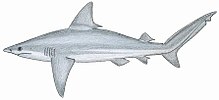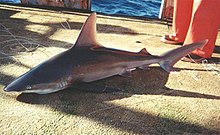The sandbar shark (Carcharhinus plumbeus) is a species of requiem shark, and part of the family Carcharhinidae, native to the Atlantic Ocean and the Indo-Pacific. It is distinguishable by its very high first dorsal fin and inter-dorsal ridge.[2] It is not to be confused with its similarly named shark cousin, the sand tiger shark, Carcharius taurus.
Illustration of a sandbar shark.
The sandbar shark, true to its nickname, is commonly found over muddy or sandy bottoms in shallow coastal waters such as bays, estuaries, harbors, or the mouths of rivers, but it also swims in deeper waters (200 m or more) as well as intertidal zones. Sandbar sharks are found in tropical to temperate waters worldwide; in the western Atlantic they range from Massachusetts to Brazil. Juveniles are common to abundant in the lower Chesapeake Bay, and nursery grounds are found from Delaware Bay to South Carolina. Other nursery grounds include Boncuk Bay in Marmaris, Muğla/Turkey[4] and the Florida Keys.[3]
Sandbar shark caught in the Atlantic.
Sandbar sharks are viviparous. The embryos are supported in placental yolk sac inside the mother. Females have been found to exhibit both biennial and triennial reproductive cycles, ovulate in early summer, and give birth to an average of 8 pups, which they carry for 1 year before giving birth.[3]
Sandbar sharks have been disproportionately targeted by the U.S. commercial shark fisheries in recent decades due to their high fin-to-body weight ratio, and U.S. fishing regulation requiring carcasses to be landed along with shark fins. In 2008, the National Marine Fisheries Service banned all commercial landings of sandbar sharks based on a 2006 stock assessment by SEDAR, and sandbar sharks were listed as vulnerable, due to overfishing. Currently, there are a small number of specially permitted vessels fishing for sandbars sharks for the purpose of scientific research. All vessels in the research fishery are required to carry an independent researcher while targeting sandbars.[3]
The longevity of the sandbar shark is typically 35–41 years.[5]
In spite of their large size and similar appearance to other dangerous sharks like Bull Sharks, there are very few, if any attacks attributed to Sandbar Sharks and so they are considered not to be dangerous to people. As a result, they are considered one of the safest sharks to swim with and are popular sharks for aquariums.
---
oh yeah, it's SHARK WEEK on discovery channel :)



No comments:
Post a Comment